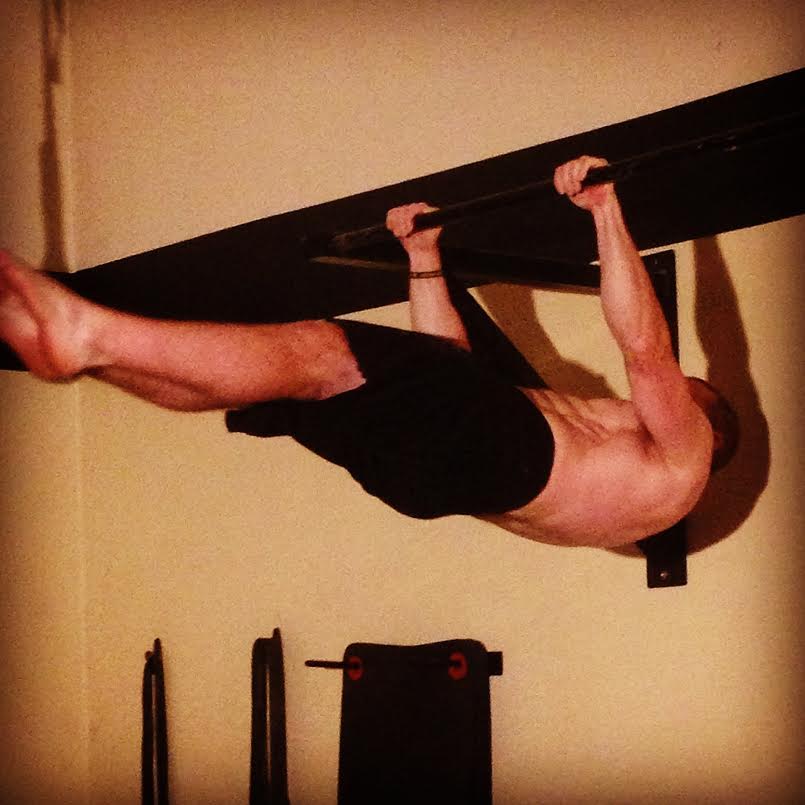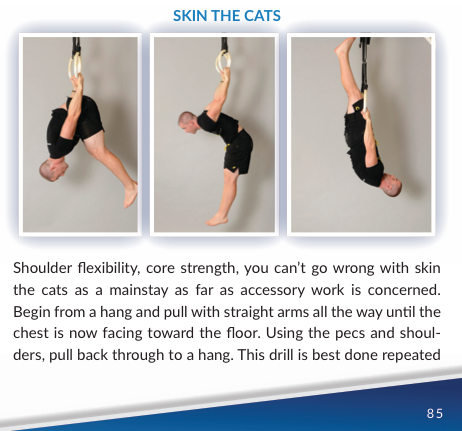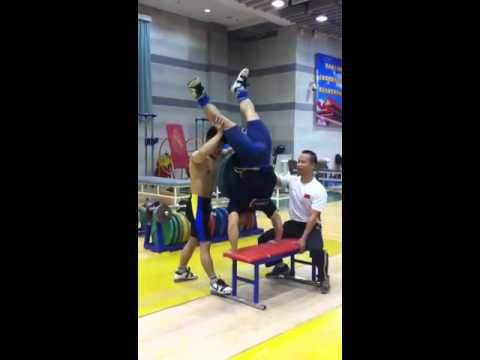Written by Max Shank
Powerlifting. Olympic lifting. Strongman. These are sports synonymous with strength. The competitors are sometimes people who are very athletic.
The trick is to focus on the things that bridge the gap between being entirely specialized to squat many hundreds of pounds and the ability to move around well (and with strength) in many ranges of motion.
My favorite big, bang-for-your-buck movements include some variations of the following:
Jump
Sprint
Handstand
Hang
The secret is knowing where to plug these into the existing program, and that’s where most people get frustrated and just say “forget this gymnastics shit.”
Jumping
Most good strength athletes are going to include some sort of bodyweight-only power work in their training, such as jumping – which is already a step ahead of the game. However, if you want to get the most possible benefit, it makes sense to include some multidirectional work in there as well.
A couple options:
Lateral Shuffle 2-Step
This is great for conditioning or for power. If you want to do this as explosive work, it had better be under 5 seconds of work!
Sprints: I don’t need to beat a dead horse; we all know that sprinting will make you faster, stronger, increase testosterone and growth hormone and most importantly allow you to chase down even the most athletic girls. Sprinting up a hill is a good way to teach you to stay up on the toes and drive into the ground.
Vertical Jumps
Broad Jumps
Both vertical and broad jumps are tried and true measurements of power to weight ratio for athletics. It would stand to reason that practicing these would help improve your power.
Lateral Bound and Stick
Standing on one leg, drive explosively laterally and land on the other leg. You’ll look like you’re a skater. Aim for a smooth and soft landing and progress by increasing height and distance of the jump slowly.
All jumping variations – if done properly – not only make you stronger, but also less likely to be injured. Look at any ACL or meniscus injury prevention and there is going to be some sort of emphasis on jumping and landing on one and two legs.
Do some bodyweight-only power work in the beginning of your session mixed with some glute activation drills (even if you are planning on performing Olympic lifts). This can serve as part of, or the finish of, your warm-up.
Handstands
Here are a couple of reasons why incorporating hand balancing of some sort into your training is a good idea.
-Improves proprioception (body awareness)
-Enhances shoulder strength and structural integrity
-Allows you to do more total volume for the shoulders
Let me explain that last one real quick.
When you do a military press with your bodyweight on the bar, you are forced to stabilize that weight through your entire body – a greater overall load. However, if you do a handstand pushup, you are no longer sandwiched between the ground and a barbell. This allows you to train more frequently, recover faster, etc., while still getting a similar training effect on the upper body pushing muscles. There is a reason that the Chinese weightlifters are continuing to utilize handstand pushups as accessory work.
If you are diligent enough in your handstand practice to do them freestanding (away from the wall), you are also going to activate deep core postural muscles to keep your body alignment. Think of it like an open chain plank.
Progressing to a single-arm handstand is by far the easiest way to improve overhead lockout strength; it’s unlikely that most people are going to be able to put their bodyweight overhead on one arm with a weight unless they are a very experienced lifter. By learning to transition from two arms to one, even an intermediate lifter can start building some awesome structural integrity and strength in the shoulders.
The other side of the spectrum in upper body pushing is the L-sit. The L-sit is also a nasty core exercise that improves active hip flexibility and core coordination. Learning how to make the transition between the L-sit and the handstand in one fluid movement is challenging but possible for any athlete over time. Use L-sits at the end of a workout as a core finisher.
Hanging
There are several fantastic exercises that involve hanging from a pullup bar or gymnastics rings.
My three favorites:
Front Levers
Single Arm Hang
Skin the Cat
All of the above are going to help improve the upper body powerhouse muscles: the lats.
This is especially true for the front lever, which at its most difficult variation, is basically an isometric straight arm pushdown with your entire bodyweight combined with the hardest plank you’ve ever done.

As you can see in the picture above, the legs are extended straight. To make this easier, simply pull the knees into the chest and try to lock down a solid body position there before progressing forward. It’s a vital tool for helping to wake up the lats.
Single-arm hangs are great for improving grip strength as well as rotator cuff and scapular function. These things are imperative for providing a strong structure for heavy benching or Olympic lifts. Just grab a bar and hang with one arm, alternating sides under control. If you want to make it extra hard, wrap a dish towel and tape it to the bar so it is a bit thicker and spins.
Skin the Cat
Done on the rings, skin the cats are probably the best bang for your buck core exercise/lat activation/shoulder mobility/looks cool drill available. Be cautious when first starting out and keep the knees as close to the chest as possible to avoid any accident when going over the top into shoulder extension. Go slowly and increase range of motion progressively. This is a good core/shoulder finisher or a great warm-up if you’re already quite skilled and strong in the movement.
 The great part about bodyweight training is sometimes just that it’s fun, different, and offers you a certain amount of freedom training-wise. In fact, you can combine some of the movements above. Again, not impossible for ANYONE who puts in the time – I was never a gymnast and couldn’t even do a pullup when I was 19. One major benefit that I have seen with adding some bodyweight movements is the ability to do them periodically throughout the day. This is especially true with handbalancing and hanging variations. Your body will adapt to the stimulus and it won’t prevent you from still getting after it and moving heavy weights as long as you are staying away from high levels of exertion.
The great part about bodyweight training is sometimes just that it’s fun, different, and offers you a certain amount of freedom training-wise. In fact, you can combine some of the movements above. Again, not impossible for ANYONE who puts in the time – I was never a gymnast and couldn’t even do a pullup when I was 19. One major benefit that I have seen with adding some bodyweight movements is the ability to do them periodically throughout the day. This is especially true with handbalancing and hanging variations. Your body will adapt to the stimulus and it won’t prevent you from still getting after it and moving heavy weights as long as you are staying away from high levels of exertion.
Simple way to implement a few of these:
- Do a couple sets of jumping in your power phase prior to heavy lifting. If you are planning to Olympic lift, jump first.
- Do some hand balancing as skill work before your heavy pushes or on a day where you are focusing on lower body.
- Another good option is to hang and handstand at the end of your workout as an accessory superset.
- Sprinting is a similar animal to jumping. If you are going to do very short distances (30m or less), you can do them prior to your weight training. I personally find that doing these on a different day or as an easy finisher is best. The important thing is that you get it in when you are not in danger of pulling a hammy. Sprinting uphill will lower your risk for injury as well as keeping you on your toes.
Find a way to incorporate some bodyweight strength training into the program and I promise you will see some great benefits to your overall athleticism, helping you crush bigger weights for longer.
Related Articles
Herschel Walker and Bodyweight Beast Building
Max is an author, coach, and owner of Ambition Athletics in Encinitas, CA. He also competes in a wide variety of sports ranging from Muay Thai and Jiu Jitsu to Scottish Highland Games. Max’s desire to constantly improve his knowledge and personal skills has led him to be a sought-after international presenter of his unique and pragmatic blend of strength, flexibility, health, and overall athleticism.
https://www.facebook.com/MaxShank
Instagram: maxshank
Twitter: maxshank





